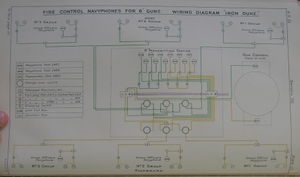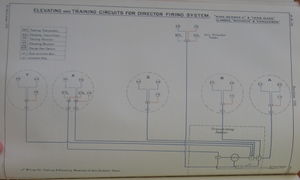Iron Duke Class Battleship (1912)
Contents
Armament
Guns
Torpedoes
Four broadside tubes, the forward ones bearing 80 degrees and the aft tubes bearing 100 degrees.[1]
Fire Control
Phones
Main Battery
Secondary Battery
Each of the six 2-gun groups was on its own navyphone circuit, feeding a Pattern 2464 Navyphone for the group officer as well as a pair of Telaupads for each gun. These led to six 2-way C.O.S.es in the 6-in TS which would dictate whether the given 6-in group's phones were tied to either
- the Pattern 2463 Navyphone and its associated Pattern 2465 transmitter
- the single 2464 in the GCT for its broadside.
Additionally, when the C.O.S. was in position one, each group's panel in the TS had a grouping switch so that any transmitter could address either or both of the other groups on its broadside. See the notes on the gunnery groups to see how this loosely mimics the fire control instruments.[2]
Rangefinders
The TCT rangefinder, initially a 9-foot instrument of unknown model, sat on an M.Q. 8 mounting.[3]
Sometime, likely not before 1918, these were to be upgraded to 15-foot instruments, with new armoured hoods and racers and training driving the hood directly rather than through the rangefinder mounting. These rangefinders lacked hand-following gear to facilitate in transmission of range cuts, and when it was considered as an addition around 1917, space concerns were causing issues.[4]
By 1918, two additional 9-foot instruments were also to be provided for torpedo control, abreast the captain's sea cabin, except on Iron Duke, where they were placed on either side of the lower charthouse platform, displacing a pair of 23-in signalling searchlights to the compass platform.[5]
Evershed Bearing Indicators
All 4 units were likely fitted with this equipment before late 1914.[Inference][6]
However, it is clear that all 6-in guns had a bearing indicator fitted.[7] This strongly implies that a rich installation supported the main battery at least.
Otherwise, one might reasonably assume the particulars resembled those of the King George V class.[Inference]
Mechanical Aid-to-Spotter
At some point, all ships in this class were equipped with four Mark II Mechanical Aid-to-Spotters:
- one on each side of the foretop, driven by flexible shafting from the Evershed rack on the director
- one on each side of the Gun Control Tower employing an electrical F.T.P. system.
As the need for such gear was apparently first identified in early 1916, it seems likely that these installations were effected well after Jutland.[8]
Gunnery Control
The control arrangements were as follows.[9]
Control Positions
Main battery:
- Gun control tower
- 'B' turret
- 'X' turret
Each 6-in broadside:[10]
- GCT (abreast conning tower)
- Alternative positions aft (Groups 1 & 2 from one, group 3 from a second one)
Some ships had C.O.S.s within the control positions so they could be connected to either TS.[11]
Control Groups
The five 13.5-in turrets were each a separate group with a local C.O.S. so that it could be connected to
- Transmitting Station
- Local control from officer's position within turret
The 6-in guns were formed into three 2 gun groups on each side[12], and the circuits for each side are led through one of two 3-way C.O.S.es offering the following modes:[13]
- each group on that broadside worked by its own transmitters in the TS
- the broadside as a whole is connected to the adapted Vickers range clock situated in its 6-in GCT
- each group on that broadside is connected to the alternative control position, where (1? 3?) portable range-and-deflection transmitters with tell-tales are used.
See the section below for a diagram.
Directors
Main Battery
The ships were fitted with a cam-type tripod-type director in a light aloft tower on the foremast along with a directing gun in 'X' turret.[14][15]
The main battery could be divided into forward ('A', 'B' & 'Q') and aft ('X' & 'Y') groups for split director control.[16]
A C.O.S. in the TS afforded these options:[17]
- All turrets on aloft tower
- All turrets on directing gun
- Forward group on aloft tower, aft group on directing gun
Secondary Battery
The ships had a pair of directors fitted to port and starboard on the forward superstructure to direct the 6-in broadside guns. Marlborough's were pedestal-mounted, and the others tripod-mounted.[18]
Torpedo Control
By the end of 1915, all four ships had been equipped with a Torpedo Control Plotting Instrument Mark I in their TCT.[19]
Transmitting Stations
Like Tiger and possibly later ships,[Inference] these had a TS for the main battery and another for the 6-in secondary battery.[20] It is not clear to me whether the secondary battery's TS had a Dreyer table.
Dreyer Table
In June 1918, Marlborough had a Mark I Dreyer Table while the other three units had Mark IV Dreyer Tables[21] and all had been provided Dreyer Turret Control Tables.[22] The disparity in Dreyer Marks creates a loose impression that all ships were initially given Mark I tables and for some reason Marlborough missed her chance for an upgrade, perhaps due to her damage at the Battle of Jutland.
Fire Control Instruments
Continuing the pattern established in the Colossus class, all 4 units used Vickers F.T.P. Mark III range and deflection instruments to the gun sights (except Mark III* in the 6-in TS panels) and Barr and Stroud (probably Mark II* or later[Inference]) instruments for other purposes.[23]
The Mark III F.T.P. range receivers on the 6-in guns were fitted with Usborne Accelerating Gear. An adapted Vickers Range Clock similar to that used in the Mark I Dreyer Table could be employed to relay ranges to the 6-in guns. An operator on the clock would have to follow-the-pointer to transmit the ranges. Each 6-in broadside had its own independent Captain's cease fire gong circuit. Firing keys were Pattern 872, and each gun had a fire gong.[24]
The ships also had Gun Ready signals in the TS and control positions, but had no Target Visible signals.[25]
Secondary Battery
A description of the fire control system for the 6-in guns is found in the Annual Report of the Torpedo School, 1913.
See Also
Footnotes
- ↑ Annual Report of the Torpedo School, 1918, p. 51.
- ↑ Annual Report of the Torpedo School, 1913, p. 103 & Plate 55.
- ↑ Annual Report of the Torpedo School, 1918, p. 175.
- ↑ Annual Report of the Torpedo School, 1917, p. 198. (C.I.O. 481/17)
- ↑ Annual Report of the Torpedo School, 1918, p. 177.
- ↑ They are not mentioned in the pertinent section of Handbook for Fire Control Instruments, 1914
- ↑ Annual Report of the Torpedo School, 1913, p. 102.
- ↑ The Technical History and Index: Fire Control in HM Ships, 1919, pp. 25-6.
- ↑ Handbook for Fire Control Instruments, 1914, p. 7.
- ↑ Annual Report of the Torpedo School, 1913, Plate 54.
- ↑ Handbook for Fire Control Instruments, 1914, p. 7.
- ↑ Annual Report of the Torpedo School, 1913, Plate 54.
- ↑ Annual Report of the Torpedo School, 1913, p. 102.
- ↑ The Director Firing Handbook, 1917. pp. 88, 142.
- ↑ Annual Report of the Torpedo School, 1913, Plate 56.
- ↑ The Director Firing Handbook, 1917, p. 88.
- ↑ The Director Firing Handbook, 1917. p. 88.
- ↑ The Director Firing Handbook, 1917. pp. 143.
- ↑ Annual Report of the Torpedo School, 1915, p. 60.
- ↑ Handbook for Fire Control Instruments, 1914, pp. 6-7.
- ↑ Handbook of Capt. F.C. Dreyer's Fire Control Tables, p. 3.
- ↑ absent from list in Handbook of Capt. F.C. Dreyer's Fire Control Tables, p. 3.
- ↑ Handbook for Fire Control Instruments, 1914, pp. 72.
- ↑ Annual Report of the Torpedo School, 1913, p. 102 & Plate 54.
- ↑ Handbook for Fire Control Instruments, 1914, p. 11.
Bibliography
- Template:BibUKARTS1913
- Template:BibUKFireControlInHMShips1919
- Admiralty, Gunnery Branch (1914). Handbook for Fire Control Instruments, 1914. G. 01627/14. C.B. 1030. Copy 1235 at The National Archives. ADM 186/191.
- Template:BibBrooksDreadnoughtGunnery
- Template:BibUKDirectorFiringHandbook1917
- Template:BibUKDreyerTableHandbook1918


